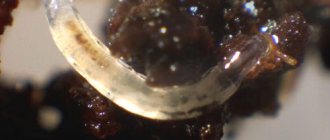Victoria Rashidovna Khazimulina
veterinarian Petstory
The liver is, without exaggeration, one of the most important organs. It performs the functions of neutralizing toxins, storing nutrients, some vitamins and microelements, such as vitamin A and iron. It produces bile, which is necessary for digestive processes. The liver is the hottest organ in the abdominal cavity and has amazing regenerative properties. If we describe all the processes in which the liver is involved, one article will not be enough.
Here we will try to analyze the most basic types of disruption of its operation. Let's talk about what symptoms you should pay attention to and how to prevent liver disease in dogs.
Liver diseases in dogs: the main thing
- The liver is a complex organ that is involved in most processes in the body;
- Liver diseases are as diverse as its functions;
- Symptoms of liver disease can be subtle and nonspecific;
- Diagnosis includes a thorough examination, medical history, blood tests and ultrasound. Sometimes additional methods are required (biopsy, histology);
- Treatment of the liver should be comprehensive and should primarily be aimed at the cause of the disease;
- Prevention includes proper nutrition, timely preventive measures (vaccination, treatment for parasites), medical examination (periodic examinations by a doctor).
Possible complications
One of the main functions of the liver is to neutralize toxins that enter the body. When an illness occurs, the organ cannot cope with its functions, and as a result, the poisoning of the body becomes systematic. Toxicosis occurs - a life-threatening condition for the animal. All organs and systems suffer. Hepatic encephalopathy develops.
With severe cirrhosis, ascites, gastrointestinal bleeding, anemia and hepatic coma develop.
Ascites is one of the complications of the disease
Classification of diseases
The liver performs many complex functions, which determines the variety of pathophysiological disorders that manifest themselves in diseases of this organ.
Liver diseases in dogs can be divided into three large groups.
- Inflammatory diseases. These are acute or chronic liver diseases that occur in response to damage or the action of a pathogen (infection, toxins). They are accordingly divided into:
- Infectious. Bacterial (leptospirosis, abscess), viral (infectious canine hepatitis) and parasitic (roundworm, toxocara);
- Non-infectious. Chronic hepatitis, cirrhosis, fibrosis caused by toxins and drugs, autoimmune processes.
- Non-inflammatory diseases, they are also degenerative (degenerer - deteriorate, degenerate). They include:
- Vacuolar hepatopathy (liver pathologies at the cellular level). Lipidosis (fatty liver), amyloidosis (deposition of protein-carbohydrate components in liver cells), diseases of accumulation of copper, vitamin A, vitamin D, hepatocutaneous syndrome, etc.;
- Abnormalities of blood vessels. Congenital portocal anastomoses, shunts, portal vein hypoplasia, intrahepatic fistula, etc.;
- Tumors/neoplasms (primary or metastasis).
- Biliary tract diseases:
- Cholestasis – blockage of the bile ducts;
- Cholangitis – inflammation of the bile ducts;
- Cholecystitis is inflammation of the gallbladder wall.
Risk group and routes of transmission
Liver cirrhosis has a genetic predisposition. Labradors, Dobermans and cocker spaniels are prone to the disease.
Also at risk are animals with chronic diseases of the digestive system and dogs that are regularly exposed to toxins.
Doberman Pinschers are prone to liver cirrhosis
Symptoms of liver disease in dogs
The liver has a huge reserve of power and enormous regeneration potential. Therefore, diseases manifest themselves clinically only after these reserves have been exhausted. Often, the symptoms of liver problems in a dog can be subtle, so you should be especially careful to monitor any deviations in your pet’s behavior.
- Early symptoms and signs of liver disease in dogs:
Decreased appetite or refusal to eat;
- Loss of body weight;
- Drowsiness, lethargy, refusal to play;
- Vomit. It can be either acute (several times a day) or periodic (for example, once a week);
- Diarrhea;
- Polydipsia/polyuria – increased thirst and increased urine volume;
- If a dog has liver pain, it may exhibit the following symptoms: yelp when picked up, take unnatural positions, and perform previously familiar movements with great caution.
- Icterus - yellowness of the mucous membranes, sclera, skin. A yellow-orange color may appear in urine and serum when tested;
- Pale (acholic) feces. The fact is that stool is colored brown by the substance stercobilin. It is found in bile, and if bile is not produced or not released in sufficient quantities, the color of the stool will be much lighter or completely white.
Visit to the veterinarian
Visit your veterinarian promptly. Don’t be afraid or embarrassed to check in with the doctor once again, because he definitely won’t do anything bad to your faithful dog. Going to him should become a habit. To the question: “Why?” You can say a phrase from veterinarians: “A timely diagnosis enormously increases the chances of a complete recovery.”
The dog is one of the most loyal animals to humans. If you decide to let such a pet into your life, then you need to understand that you are taking on great responsibility for its life and health. Take care of your dog and monitor its health. May she live a happy life.
Diagnostics
Diagnosis of liver diseases in dogs must be comprehensive. First of all, a thorough history and examination is needed. Most of the symptoms listed above are nonspecific, that is, they can manifest themselves in diseases of the liver, for example, in diseases of the intestines, pancreas, some infections and poisoning. Accordingly, before treating a dog’s liver, you need to conduct a full diagnosis:
- Careful history taking. The doctor will analyze in detail the aspects of keeping the pet, its diet, previous diseases, medications, preventive treatments and vaccinations, etc.
- Inspection. At the appointment, the doctor will assess the condition of the mucous membranes, their color, humidity, pain in the abdominal wall, body temperature, etc.
- Clinical blood test. It will allow you to assess whether there is an inflammatory process in the body, hemolysis (destruction of red blood cells), anemia, an infectious or acute inflammatory process, and sometimes a clinical blood test can even suspect a neoplastic (tumor) process.
- Blood chemistry. Will allow you to assess the degree and nature of liver damage, the level of intoxication, and organ damage.
- General and biochemical urine analysis. Changes in the analysis, such as the presence of bilirubin, ammonium biurate crystals, changes in urine density, may indicate liver disease.
- Ultrasound examination of the abdominal cavity. It will allow you to assess the size of the liver, changes in its structure, the condition of the biliary tract, blood vessels, and the presence of neoplasms.
- Infection studies. Such as leptospirosis, infectious canine hepatitis.
Additionally, studies such as biopsy, portography, and blood clotting assessment may be required.
Liver treatment in dogs
For any disease, therapy must be comprehensive and include several factors. As we said earlier, the liver is an organ that covers many functions; liver diseases have a significant diversity, not to mention the fact that they are often a complication of another disease. Therefore, treatment for a dog's diseased liver can vary greatly depending on the cause of the disease, the severity of symptoms, age, and other factors. Treatment may include the following measures and groups of drugs:
- Antispasmodics and painkillers;
- Droppers. Often, liver diseases are accompanied by dehydration, intoxication, and electrolyte disturbances. Intravenous infusions help normalize these indicators, and recovery occurs faster;
- Antidotes. In case of poisoning with known substances, antidotes can be used to quickly neutralize poisons and toxins;
- Antibiotics/antimicrobials. For infections and infestations;
- Hepatoprotectors. This is a group of drugs that have a positive effect on the restoration of liver cells;
- Diet. During illness, you need to transfer your pet to specialized dietary food (specialized food or an individual diet prepared by a doctor). The food should be easily digestible, not burden the liver, and contain sufficient amounts of antioxidants, vitamins, and protein;
- Antihelminthic drugs;
- Antiemetic drugs. With vomiting or nausea;
- Enterosorbents. For diarrhea and poisoning. They bind many toxic substances in the intestines. Thus, they are safely excreted from the body with feces;
Some pathologies require surgical intervention. For example, with large tumors or shunts.
Prevention
In order to prevent liver disease in your pet, you need to follow just three simple rules:
- Balanced, complete diet;
- Timely preventive measures (vaccination, treatment against parasites);
- Medical examination (can be combined with annual vaccination).
Hurry up, choose a box and find out what gift awaits you
Discount on pet insurance
Promo code copied to clipboard
Let's talk about each point in more detail.
Diet
You can feed your pet commercial complete food. The main thing is to choose the type of product that suits him. There will usually be information on the label to help with this. For example, food for miniature breeds up to 6 years old or food for adult dogs with high activity, etc.
If you are a fan of homemade diets, then you need to approach its preparation correctly. You should not give your pet food from the table (cookies, sweets, fried, salty, etc.).
The source of protein is the most important part of the diet. It should be easily digestible and complete, there should be enough of it. You can use turkey, chicken, beef, meat by-products (just be careful with liver, it should be given very carefully and rarely, due to the excess vitamin A in it). Essential fatty acids (found in vegetable oils and fatty fish) must be added to the diet, and carbohydrates (porridge, vegetables) are needed for normal intestinal function. To create optimal proportions, it is better to contact a veterinary nutritionist. You can even do this online – in the Petstory mobile application. You can download it from the link.
Vaccination
Diseases such as leptospirosis and canine viral hepatitis affect the liver. The good news is that vaccines have long been available for these infections.
All pets need to be vaccinated, even if they don't go outside or if you don't allow other dogs near your pet while walking. The fact is that you can bring many infections home on clothes or shoes, and for infection (for example, parvovirus enteritis of dogs) it is not at all necessary to come into direct contact with the infected person; contact with his excrement is enough, which is quite possible when sniffing the ground. If you often walk with your pet in the field or forest, or hunt with it, then vaccination against leptospirosis should be given special attention.
Vaccinations need to be done once a year. This is a low-cost way to avoid many health problems in the future.
Treatment for parasites
The situation with treatment against parasites is the same as with vaccination. It doesn’t take any special effort for a new life to emerge inside your pet. He can simply sniff or lick the unfortunate pebble (or not a pebble), and after a couple of weeks he will secrete parasite eggs everywhere, including your home.
Flea and tick treatment is equally important. Fleas carry some types of worms, and ticks cause vector-borne diseases that affect many organs, including the liver.
Treatment for helminths must be carried out for preventive purposes once every 3 months (for puppies up to a year, once every month and a half). It is necessary to treat your pet against external parasites during the entire time when the air temperature outside is above zero.











